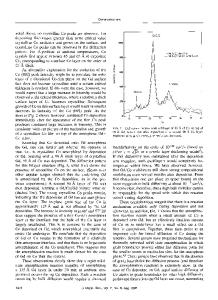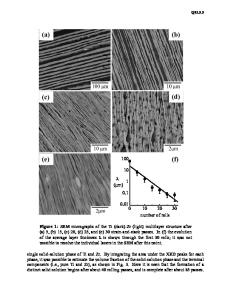Amorphization reaction of Ni-Ta powders during mechanical alloying
- PDF / 1,121,577 Bytes
- 7 Pages / 612 x 792 pts (letter) Page_size
- 46 Downloads / 341 Views
I.
INTRODUCTION
PREPARING amorphous alloys based on IVa to VIa group refractory transition metals is highly attractive, since amorphous phases of these high melting temperature alloys possess high crystallization temperatures.[1] However, the high cooling rate necessary to bypass the nucleation and growth of crystalline phases in the undercooled alloy melts always severely restricts, for instance, amorphization of the alloy with a high melting temperature by the liquid quenching method.[2] As previous investigations demonstrated, amorphous materials can be obtained by destabilizing a solid phase’s crystallinity by a solid-state reaction.[3,4] Various techniques to synthesize amorphous alloys via solidstate amorphization include hygrogenation, multilayer interdiffusion, and mechanical alloying (MA).[5,6] Mechanical alloying was developed by Benjamin in the early 1970s to produce superalloy powders strengthened by oxide dispersions.[7] It is a high energy ball milling process consisting of repeated mechanical mixing, cold welding, fracturing, and rewelding of powders during ball-powder collision events.[8] Owing to this unique novel milling behavior, MA allows materials scientists to circumvent material limitations and manufacture alloys that are difficult or impossible to produce by conventional melting and casting techniques. For instance, other investigators used MA to successfully synthesize many equilibrium and/or nonequilibrium phases in many alloy systems, including amorphous materials, quasicrystals, nanocrystalline materials, rare earth magnets, and intermetallics.[9,10] Since the discovery of amorphous phase in mechanically alloyed Ni60Nb40 powder,[11] this technique has been applied to numerous amorphous materials.[6,9,10] However, the NiTa binary system has received only limited attention. PEE-YEW LEE, Professor and Director, and CHUNG-KWEI LIN, Visiting Associate Professor, are with the Institute of Materials Engineering, National Taiwan Ocean University, Keelung, Taiwan 202. JU-LUNG YANG, Engineer, is with Sino-American Silicon Products, Inc., Hsinchu, Taiwan 300. HONG-MING LIN, Professor and Chairman, is with the Department of Materials Engineering, Tatung Institute of Technology, Taipei, Taiwan 104. Manuscript submitted November 22, 1996. METALLURGICAL AND MATERIALS TRANSACTIONS A
Therefore, this study investigates the feasibility of preparing amorphous Ni-Ta powders by MA, starting from elemental Ni and Ta powders and using a shaker ball mill.
II.
EXPERIMENTAL DETAILS
A. MA Processes Elemental powders of Ni (99.98 pct, ,300 mesh) and Ta (99.98 pct, ,325 mesh) were weighed to yield the desired compositions, NixTa1002x (x 5 10, 20, 30, 40, 50, 60, 70, 80, and 90), and then canned into an SKH 9 high speed steel vial (40 mm in diameter and 50 mm in height) together with Cr steel balls (7 mm in diameter with ball-topowder ratio 5 2:1) under an argon-filled glove box, where a SPEX* 8000 shaker ball mill (1200 rpm) was employed *SPEX is a trademark of SPEX Industries, Edison, NJ.
for MA. The overall
Data Loading...











